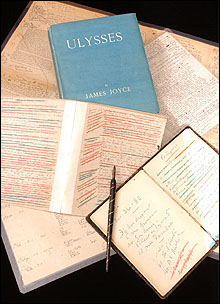Archives
Items from UB's Joyce collection sent to Ireland for Bloomsday anniversary
By PATRICIA DONOVAN
Contributing Editor
The 100th anniversary of Bloomsday is in the wings and several treasured items from the UB Libraries' James Joyce Collection have been packed up and sent off to Ireland for the largest celebration of that anniversary in the world.

James Joyce's handwritten
notebooks, typescripts,galley proofs and page proofs for the first
edition of "Ulysses."
PHOTO: NANCY J. PARISI
UB has the largest single collection of James Joyce materials in the world. It also is the only collection that holds significant materials from his entire writing career.
James Joyce chose June 16, 1904, the date he met his wife, Nora, as the date of the stream-of-consciousness journey undertaken by his protagonist, Leopold Bloom, through Dublin's emotionally charged cityscape and his exhausted return home to the imprint of his wife's lover upon his sheets.
Because Bloom is the "Ulysses" of the novel—one of the most influential books of the 20th century—June 16 is known to Joyce aficionados throughout the world as "Bloomsday."
It is celebrated annually with readings from the novel, exhibitions, lectures, film series, concerts (Joyce was a noted singer and music lover), visits to all of the places mentioned in the book and eating of the favorite foods of Leopold Bloom, such as pork kidneys and other "innards of beasts."
This year, on the 100th anniversary of that auspicious date, Joycean celebrations abound, particularly—but not exclusively—in Dublin.
One of that city's principal anniversary events will be "James Joyce and Ulysses at the National Library of Ireland (NLI)," an exhibition that will open in June and feature materials from the UB collection, along with the NLI's own manuscripts, first editions, and literary and biographical items.
Samuel Slote, the UB Joyce collection's scholar-in-residence, prepared the materials from the collection for travel to Ireland to round out the exhibition.
Among the UB items are two of Joyce's canes; portraits of Joyce, Nora and Joyce's father that were in the Joyce family for decades; typescripts (UB has the world's largest collection of typed manuscripts for "Ulysses"); galley and page proofs with revisions and additions in Joyce's hand, and a handwritten draft of part of the novel's "Circe" episode, the single most valuable contribution to the NLI exhibit.
Slote points out that one-third of "Ulysses" actually was written in the galley-proof stage, which famously drove Joyce's printers' nearly mad.
Also travelling to Ireland will be a poster printed by the Sporting Times, the last known copy in existence, that advertises to the British man or woman in the street the "scandal of Ulysses;" a small copy of the statue of Joyce that marks his gravesite in Zurich's Fluntern cemetery—a site from which the braying of lions at a nearby zoo can be heard. Slote quotes "Finnegans Wake": As the lion in our teargarten remembers the nenuphars (water lilies) of his Nile...
The NLI curators say a major emphasis of the exhibition will be Joyce's writing methods, which they will exhibit "in terms that are readily understood as the steps in the artistic process that guide all creative endeavours."
The writing or formation process—poesis—used by major 20th-century authors, including Joyce, is the focus of UB's Joyce collection
"We have the most comprehensive collection of 'Ulysses' materials, as well," Slote notes, "from notebooks, handwritten early drafts and holographic manuscripts to typescripts, printer's proofs, the first edition, the first serializations. We have other important editions, as well, including more than 100 editions in languages other than English.
"Other collections offer bits and pieces of such items, and some collections, like that of the NLI, are very significant. The UB collection, however, includes original elements of most of the steps employed by Joyce as he created the novel," Slote says, "which is why the collection is used by so many Joyce scholars."
The continuing fascination with Joyce and, in particular with "Ulysses," is due, says Slote, to a number of factors, including the fact that Joyce was endlessly inventive.
"He was a master of idiomatic English speech," Slote says, "spoke several other languages, including Italian, French and German, and was an acute observer of the human condition. He insisted on its honest representation, regardless of how 'vulgar' some may have found it at the time it was published."
"Obsessed with what language is and what it does, Joyce, more than any other writer, I think, brought formidable tools to his effort to evoke what it is to be a human being. He employed astounding command of a wide range of writing and speaking styles to demonstrate the reality of modern experience," Slote says.
The notebooks in the UB collection reveal that Joyce collected references from everywhere, from death notices to weather reports to bits of geology, music, science, foreign literature, mythology. He jotted them down, crossed them out as he used them and reproduced them in a cacophonous catalogue of life as lived, illustrated with verbal maps, subliminal suggestions, memories, bits of song cycles and articulated sensualities of every kind.
"The text is as rich and complex as life itself. It is full of color, music and great wit. It is really a very, very funny book and a poignant book," Slote says.
"Joyce used language so astutely and many kinds of geographic and historical games, complex cross references reflected back and forth across different chapters and a wonderful narrative that echoes the voice of whatever it is that he is describing. This complexity, cross-referencing and endless hidden intrigue may account for why so many readers never feel as if they have finished 'Ulysses' and why it is considered by so many, many readers as one of the most significant books of the past 100 years."
